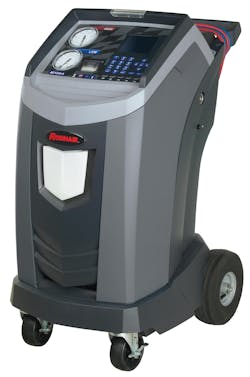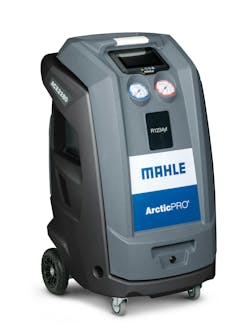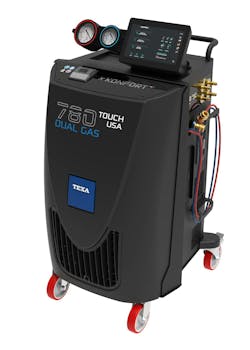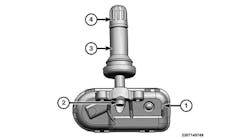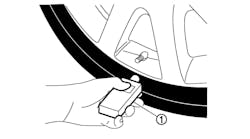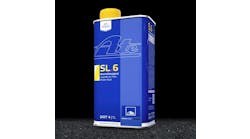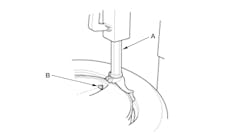As the automotive industry continues to evolve, so do the technologies and methodologies used in vehicle air conditioning (A/C) systems.
In this comprehensive overview, we delve into the emerging trends and innovations in automotive A/C technology with insights from leading experts at Bosch Mobility Aftermarket, Chemours Co., Mahle Aftermarket Inc. and Texa USA. From cost-effective leak detection methods to the transition to eco-friendly refrigerants, discover how these advancements are shaping the future of vehicle AC servicing.
The experts also offer help and resources to help technicians unearth the latest training opportunities.
MTD: What new trends are you seeing in the air conditioning world? Any new trends in technology or in the service approach?
Justin Fisette, senior product marketing manager, Bosch Mobility Aftermarket: One trend is looking for less costly methods of leak detection than traditional dye, because of the cost of 1234yf. Charging a system, adding dye and looking for leaking refrigerant could cost a shop hundreds of dollars of refrigerant. Using tracer gas, which is 95% nitrogen and 5% hydrogen, is much less expensive and helps shops detect smaller leaks. We introduced our LD9-TGKIT tracer gas leak detector kit to help shops find leaks in all A/C systems, especially those using YF, to save money and find leaks faster.
Danielle Lovett, market development leader, automotive aftermarket, Chemours Co.: As an innovator and a manufacturer of high-performing, lower global warming potential (GWP) refrigerants, Chemours is especially tuned in to new technology in the mobile air conditioning and thermal management space. We have driven air conditioning innovation for nearly a century, which continues with R-1234yf (Chemours Opteon YF), which has become the preferred refrigerant solution for many global automotive manufacturers. In automotive, we’re seeing a huge shift from the legacy refrigerant R-134a, a hydrofluorocarbon, or HFC, to the new-generation R-1234yf, a hydrofluoroolefin, or HFO.
Chemours manufactures R-1234yf here in the United States, and, in fact, we are one of the world’s largest manufacturers of this refrigerant. Already in 2024, we’ve seen growth for the refrigerant to supply the automotive aftermarket. More than a trend, R-1234yf is here to stay and is widely accepted as the “future of automotive refrigerants — in use now.” One of the predominant reasons for this is environmental. R-1234yf has a global warming potential (GWP) of less than one (AR5)—compared with R-134a’s GWP of 1,300 (AR5).
Today there are more than 95 million vehicles on U.S. roads that are charged with R-1234yf, with approximately 15 million vehicles in that fleet coming out of warranty each year. So, another trend we’re seeing is that R-1234yf is gaining traction in aftermarket shops, which are making the transition by ensuring they have the product and equipment necessary to service both R-134a and R-1234yf vehicles.
Brian Messenger, head of product management, workshop engineering and technical support, Mahle Aftermarket Inc.: Refrigerant change. 134a is banned for new LD vehicles in the U.S. as of October 2024. 134a production is being reduced by EPA [Environment Protection Agency] mandate for all HFCs in the U.S. 1234yf could possibly be caught up in PFAS bans in Europe and U.S. unless exemptions are made. Carbon dioxide (CO2) and possibly even propane could be coming more prevalent in the United States before 2030.
Blended refrigerants will likely pick up the void in the aftermarket as some of these refrigerants get phased out. 134a will be phased out of HD trucks/buses and appears 1234yf is where many are headed. Diagnostic tools are becoming increasingly more necessary to properly diagnose AC issues. On-board diagnostics like reading the vehicle’s pressure transducers in the system and being able to command pumps/valves/compressors in newer EVs are almost essential to diagnose quickly; cooling fans are controlled with duty cycle now and the old method of visually checking the fan operation is not sufficient for ensuring proper heat exchange across the condenser.
Off-board tools like variable compressor testers and especially leak detection tools like hydrocarbon sniffers or CO2 foam sprays are especially needed as well. These have always been a need, but with 1234yf machines not allowing charges without passing the leak tests means the old days of just topping the customer’s refrigerant and sending them on their way without fixing the leak are numbered as it is forcing some techs to fix the root cause, not the symptom.
Fabio Mazzon, technical manager, Texa USA: Air conditioning services are getting more sophisticated to meet the new EPA regulations. There are new refrigerants and new refrigerant blends entering the market, together with new technologies, to recover as much refrigerant as possible during a service (and) to limit (the) release of gas in the atmosphere. New technologies like Forming Gas are available also for more efficient leak detection.
MTD: What tools or technologies does your company offer to help with servicing A/C units in vehicles?
Fisette (Bosch): Robinair offers the industry’s most efficient recovery machines, meaning shops can remove more refrigerant from a vehicle to ensure a more accurate recharge. This also helps shops recycle more refrigerant for potential re-use or safe disposal.
(We have) a full line of accessories, including oil inject syringes, UV dye, leak detectors, vacuum pumps, manifold gauges and more — (which) provides techs with everything they need to service AC systems.
Lovett (Chemours): Chemours is one of the world’s largest manufacturers of R-1234yf (branded Chemours Opteon YF) and recently invested in a major expansion of our manufacturing facility near Corpus Christi, Texas, to ensure the R-1234yf supply is strong and ready to support the growing demand worldwide.
Because vehicles with R-134a AC systems will exist — and require service — for the foreseeable future, we need to make sure aftermarket shops have enough supply to meet the need. As the American Innovation and Manufacturing (AIM) Act continues to phase down the production and consumption of HFCs such as R-134a, a strong recovery, recycling and reclamation program for this refrigerant will become increasingly important to the supply chain.
Messenger (Mahle): (We offer) PAG/POE injector kits for YF services; UV dye light; component flush kit; refrigerant leak detector; vehicle communications interface for auto VIN retrieval; on-board vehicle database that provides refrigerant and oil amounts/types for the selected vehicle; and remote viewer app to get notified when a service needs attention if you are not in the bay.
Mazzon (Texa): Texa offers different AC recovery cart options based on the type of refrigerant and the customer needs. The Konfort 750R is a 134a fully automatic recovery machine designed to satisfy automotive and heavy-duty customers thanks to a 50-pound internal tank. The unit uses a unique push-pull cycle in order to maximize the amount of recovered refrigerant. The Konfort 760 for 1234yf only and 780 dual gas (134a and 1234yf) are fully automatic recovery stations designed with a 10-inch touchscreen that allows remote assistance. The Texa 780 dual gas is unique to the market, because this machine provides two completely separate internal systems to support the dual gas service, which means no cross contamination during service.
MTD: Are there any specific training programs or resources available for technicians who use your company’s air conditioning service equipment?
Fisette (Bosch): Robinair works closely with MACS, the Mobile Air Climate Systems Association, to promote the benefits of further education and training on existing and emerging AC technologies. We highly recommend techs become 609-certified through a MACS training course, which will help them better understand the basics of A/C service, especially as R-1234yf usage grows in new vehicles.
Lovett (Chemours): R-1234yf is classified as an ASHRAE A2L mildly flammable refrigerant, whereas R-134a is an A1 nonflammable refrigerant. Although R-1234yf is difficult to ignite and has been used safely in vehicles for more than a decade, this mild-flammability designation does require technicians to follow additional safety protocols, which are also supported by R-1234yf equipment. For example, R-1234yf requires left-handed thread fittings and special labeling. If your shop does significant R-1234yf business and uses canisters of the refrigerant, you’ll also need a separate R/R/R machine.
It’s also important to note that mixing R-134a and R-1234yf is illegal and unsafe, and it may compromise systems, performance, equipment and warranties.
Messenger (Mahle): EPA609 is a must for handling refrigerants and knowing proper methods.
Mahle prides itself on offering one of the most intuitive machines to use out of the box. Our goal is to have enough information available on the screen that the technician should need. If something isn’t clear or missing as reported by our Tech Support from customer feedback, we often add these to our free over-the-air software updates.
On-site setup and training is included with some of Mahle’s machines depending upon where they were purchased. On-site training is available through our hundreds of nation-wide service reps.
Mazzon (Texa): Texa USA offers training classes at the New Jersey office, as well as remote assistance training by use of a phone and remote assist software available within the Konfort touchscreen. The Texa library of training and troubleshooting videos is available at YouTube or the Texa website, or dealer supported training is available depending on which dealer purchased from.
MTD: How does your company support technicians and repair shops in using your air conditioning service tools effectively?
Fisette (Bosch): We’ve created an extensive library on machine function and maintenance, including how to perform each step in recovery and recharge. This helps techs learn the machine and ensure proper service techniques are used to return the vehicle to the customer in factory condition.
Additionally, we have video training on using specialized tracer gas leak detectors to quickly find leaks, and testers for variable displacement compressors to prevent a false diagnosis. These videos and tools help shops work more efficiently to identify and repair vehicle issues.
Lovett (Chemours): Chemours is in the final stages of developing a R-1234yf-specific training initiative for the automotive aftermarket. We also offer free downloadable resources on our website, Opteon.com/YF, which we update regularly to connect technicians with training resources and other information about R-1234yf.
Messenger (Mahle): Onsite setup and training is available on Mahle-branded machines plus free lifetime tech support for any inquiry and on-screen live graphs, which display more accurate accounts of pressure readings over analog gauges so technicians can really see, learn and compare what “good” and “bad” systems look like.
(Other offerings include) transparent messages to allow the user to know what the machine is doing at all times. Plus, a homepage that quickly shows all fluid levels (new/used oil/dyes and refrigerant) and filter/pump oil life. All color-coded and the refrigerant tank is color coded to indicate optimal refrigerant fill volume.
Mazzon (Texa): Texa USA has expert air conditioning technicians available to provide support at the phone, with remote connection (for Konfort 760 and 780) or on-site support if required.
MTD: How do you stay ahead of trends and advancements in air conditioning service technology?
Fisette (Bosch): Robinair and Bosch maintain relationships with nearly every original equipment manufacturer (OEM) and employ engineers and ASE-certified master technicians to ensure we stay on top of current and emerging technologies. Team members are also heavily involved in industry trade associations to help us understand what technicians in the field are experiencing or will experience.
Lovett (Chemours): For more than 100 years, Chemours — the inventor of Freon and innovator of new-generation HFO refrigerants that include R-1234yf — has stayed ahead of trends by being deeply committed to the evolution of refrigerants necessary to meet the demands of the modern world. Whether those needs encompass decarbonization, higher energy efficiency or better cooling performance, our commitment to courageous chemistry keeps us in the lab constantly, creating the better refrigerant solutions our world needs to live comfortably and sustainably.
Messenger (Mahle): Mahle maintains close partnerships with all the OEMs, not only do we have a connection on the service side as a tier one supplier to the OEMs, but an extensive portfolio of thermal products from compressors to heat exchangers and innovating new technology in HVAC to aid in carbon emission reductions.
Mahle is heavily involved in all the SAE committees and MACS conferences and sits in for all the European Union legislation working groups which provides insight to potential changes in North America
Partnerships with multiple refrigerant manufacturers validate their prototype gases as R134a production begins to wind down.
Mazzon (Texa): Texa is an AC service company that partnered with several of the OE manufacturers, to provide their dealership locations with the highest quality service equipment they trust. While making these partnership agreements, Texa is looking and paying attention to where the air conditioning world is headed for years to come. Supporting OE partnerships as well as industry associations like MACS ensures Texa keeps product development on the forefront of vehicle technology.
MTD: What tips or tricks do you have for technicians who work on A/C services for vehicles?
Fisette (Bosch): We recommend techs educate themselves with a high level of training to ensure they are aware of how modern A/C systems work, helping them identify, diagnose and repair issues.
Lovett (Chemours): Our first rule is to determine which type of vehicle you are working on — one charged with R-134a or R-1234yf. You can find this information in the owner’s manual or by checking under the hood for the manufacturer’s label, which shows the type of refrigerant the vehicle uses. Remember that, except for a few equipment and tool differences, properly and safely servicing R-1234yf vehicles requires you to continue the best practices you’ve always used — but to also adopt procedures for mildly flammable refrigerants. Also remember that mixing R-134a and R-1234yf is illegal and unsafe, and it may compromise systems, performance, equipment and warranties. Certain safety nets in equipment and tools, such as left-handed threading, will help to prevent this.
Lastly, we recommend taking a strategic approach to preparing your shop for R-1234yf vehicles, one that supports your budget and volume of business. For example, Opteon YF is available in 10- and 25-pound single-use recyclable cylinders. These are ideal for shops that perform a high volume of AC work but will require the investment in an appropriate R/R/R machine. For multiple-use charges or for servicing vehicles with greater charge sizes (such as SUVs and trucks), 28-ounce self-seal cans provide a cost-effective option, without the need for an R/R/R machine. If you are doing a small volume of R-1234yf business, Opteon 12-ounce self-seal cans provide a cost-effective option for single-use charges.
Messenger (Mahle): Always check the refrigerant identifier (RFID) filter every time you grab the machine to ensure oil doesn’t reach the sensors in the RFID unit. If oil/dye/sealant is detected, clean the internal coiled hose and install new filter. Refrigerant identification will become more of a must as refrigerant blends begin to take the market, even for R134a.
Larger capacity systems equipped with an accumulator, using a heat gun on the accumulator during recovery will speed the process by not allowing the refrigerant charge to change into a liquid state.
If a vehicle is difficult to charge completely, perform a low-side charge as the machine will prompt to start the car for the car to draw in the full charge via its own compressor. However, choosing both HS/LP is the recommended method for accuracy.
Replace the valve cores anytime you are servicing an A/C system; especially if you recover the vehicle’s charge and it is less than the OE recommendation. it is likely that refrigerant is escaping through the cores if no other refrigerant leak is detected.
Keep the tank with about 10 pounds of refrigerant available. This will allow a faster charge with minimal impact on recovery time. The vehicle fill is purely by pressure differential between the internal tank and the vehicle; if the vehicle is hot and there is only a pound or two in the internal tank, it’ll be extremely difficult or take a long time to complete the charge.
Getting moisture out of the system is the most important process, this is accomplished by sufficient vacuum; vacuum readings should reach a minimum of 29.25in Hg (inches of mercury) to ensure moisture boils and is removed from the system. Excessive moisture mixed with refrigerant creates acid destroying the system from the inside out. Desiccant filters/receiver drier on the vehicle should be replaced as preventative maintenance, doing so will aid in premature compressor failure.
When attempting to recover a refrigerant charge, it is important to have a static system prior to recovery. Allow (the) engine to idle with the A/C system off; this ensures the refrigerant charge is in a gaseous state which will aid in speed of recovery. If the A/C has recently run, oil can still be in suspension in the refrigerant and will lead to a larger than normal amount of oil being recovered from the vehicle — about 80% of the vehicle’s complete oil charge should be in the compressor at a static state. If a large amount of oil is recovered, it is likely the system had too much oil, possibly due to (the) customer attempting to use DIY refrigerant charge cans, which contain compressor oil.
Mazzon (Texa): Look into new technologies and what the market is offering in order to perform the service in the most efficient way, and be open to introduce new technologies and solutions in the shop. Texa Forming gas leak detection is one of these emerging new technologies that is commonly used with the high-end vehicle systems, but is proving to be a more efficient leak detection process. As soon as this service is more widely understood, there will be more shops wanting to use it in house to increase technician efficiency and profit margins.

